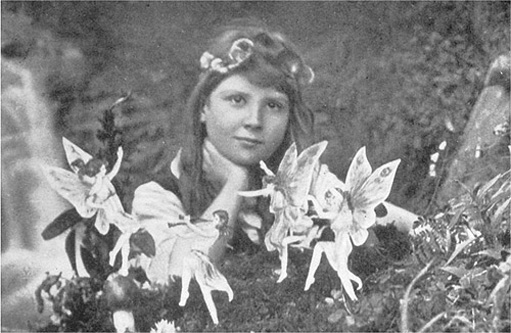6.4 Pictures
It used to be thought that a photograph could provide proof of an event – someone could be caught red-handed by a photograph, as proof of their guilt. 'The camera never lies', it was said. If you have a digital camera and have been 'touching up' photographs on your home computer you will know that this is far from true now. It is easy to lie with a digital photograph.
The idea that the camera never lies has always been a myth, however. As far back as 1917 the photographs of the Cottingley Fairies 'proved' the existence of fairies. Two girls, Elsie Wright (age 16) and Frances Griffiths (age 9), took photographs of themselves apparently in the company of fairies (Figure 30). Eventually, in 1981, the girls admitted that they had faked most of the pictures – although they always maintained that one of them was genuine.

The difference today is the ease with which digital photographs can be manipulated. It is argued that because of this, digital photography is qualitatively different from analogue photography.
One of the benefits that Taylor claimed for digital techniques is the improved options for editing, and he contrasted digital techniques with analogue techniques where 'stories cannot easily be altered'. The counterpoint to this is that digital stories can be easily altered – which makes them all the more unreliable.
This has sparked a debate about the changing nature of photography. The artist David Hockney, who has used photography in his work, has argued that the ease of editing digital images has made photography a dying art. Hockney's views were discussed in a newspaper article in 2004.
Hockney says he believes modern photography is now so extensively and easily altered that it can no longer be seen to be true or factual. He also describes art photography as 'dull'.
Even war photography, once seen as objectively 'true', has now been cast in doubt by the ubiquitous use of digital cameras which produce images that can be easily enhanced or twisted.
Hockney points to the case during the Iraq war when the Los Angeles Times sacked a photographer for having superimposed two images to make them more powerful.
Not everyone entirely agrees.
Russell Roberts, head of photography at the National Museum of Photography, Film and Television, said Hockney's argument was 'simplistic'.
Mr Roberts said manipulation of images was as old as photography. He could cite numerous examples from the 1840s, the first decade of photography, of images which claimed to be accurate depictions of events but were in fact highly stage managed.
[…]
Eamonn McCabe, a former picture editor of the Guardian, said it had become increasingly difficult for picture editors to tell whether a picture had been manipulated and a growing number of digitally manipulated pictures were being published.
'I think there was perhaps a point where there was a general perception that photography was truth, but we have lost that,' he said.
But McCabe said this did not detract from the value of good photography. 'To say that photography is dead is faintly ludicrous. It would be better to say that you should be wary of everything.'
McCabe's measured response to the consequences of digital photography, in contrast to Hockney's more sensational reaction, echos contemporary discussions comparing IT with telegraphy, films and electricity. It is suggested that you should be wary of exaggerated, utopian claims about the power of technologies. Likewise you should watch out for exaggeration in claims of the negative consequences of technology. Certainly IT has made significant changes in many areas of our lives. I hope, however, that your study of this course puts you in a more powerful position to think critically about IT, and make informed judgements on the consequences of new information and communication technologies.
